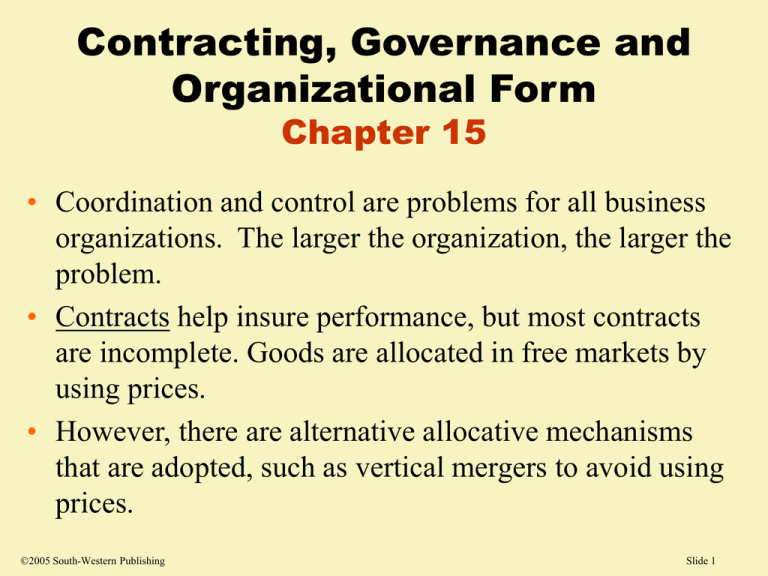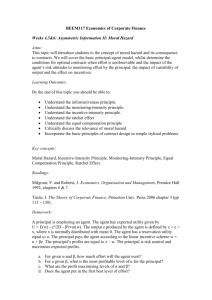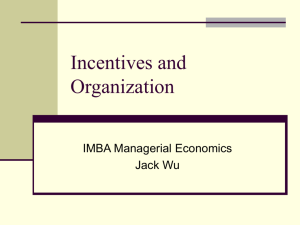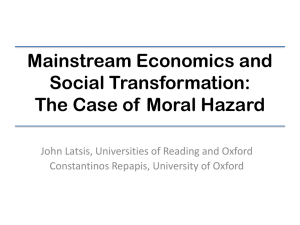Document
advertisement

Contracting, Governance and Organizational Form Chapter 15 • Coordination and control are problems for all business organizations. The larger the organization, the larger the problem. • Contracts help insure performance, but most contracts are incomplete. Goods are allocated in free markets by using prices. • However, there are alternative allocative mechanisms that are adopted, such as vertical mergers to avoid using prices. 2005 South-Western Publishing Slide 1 Role of Business Contracting in Cooperative Games • The amount of advertising and service can be viewed as a game. • The outcome can be sub-optimal; that is, it is not value maximizing. The cooperative solution sometime yields better payoffs. • To get to a value-maximizing solution, the manufacturer may have to consider side payments or credible commitments to the retailer. Slide 2 Retail Distributor & Truck Manufacture TABLE 15.1 • A retailer can but selling Truck Manufacturer effort into selling trucks • A truck manufacture can Advertise No Advertisement advertise 0 $2,000 Selling • The cooperative solution Effort is for both to continue $2,500 $3,000 Retail efforts (payoff sum is Distributor $5,000 0 $7,000) No • But retail wants to 0 Selling $2,500 Effort discontinue • A contract to pay some of retailers expenses will Payoffs for the Retail Distributor make both better off. appear in lower triangles. Slide 3 Contracts • Contracts between players are binding, they specify actions by both parties. • Contracts must assign penalties for not living up to the agreement. These payments are part of a several step sequential game. » If the retailer decides to discontinue a service for a product the manufacturer produces, then the contract can provide economic sanctions that make this decision unattractive. • A vertical requirements contract is one in which the firms in successive stages of production agree to payments and/or penalties for taking an action. » If the manufacturer spends a large amount to advertise the product, the distributor promises to promote the product as well. Slide 4 Vertical Requirements Contract • A vertical requirements contract is one in which the firms in successive stages of production agree to payments and/or penalties for taking an action. • Contracts must assign penalties for not living up to the agreement. These payments are part of a several step sequential game. » If the manufacturer spends a large amount to advertise the product, the distributor promises to promote the product as well. • Expectation damages are a remedy for breach of contract. These are payments for non-performance of a contract. Slide 5 Choice of Organizational Form • A reliant asset is a non-redeployable durable asset. Specialized equipment or specialized knowledge cannot be transferred to other uses. • In markets with reliant assets, one party could “hold-up” the other party. The choice of organization will require explicit contracts. • The likely outcome is franchise contracts. • Relational contracts are promissory agreements of coordinated performance. A jet charter company is a good example. Slide 6 Vertical Integration • An alternative to contracts between two parties is vertical integration. If the retailer and manufacturer merge, then both interests are reflected in a decision whether or not to advertise or expand service. • Spot markets present few incentive or informational problems. » The purchase of a dozen ears of corn at a roadside stand or the sale of electricity at a spot rate off the grid, are examples of spot markets. » The products are relatively standardized and sold for immediate delivery. Slide 7 Incomplete Information and Incomplete Contracting • Incomplete Information -- uncertain knowledge of payoffs, choices, or types of opponents a market player faces. • Insurance works when we can pool a group of possible events (like injuries at work) to reduce the risk of loss to any one party. • But some risks are catastrophic, like a nuclear accident. It is difficult to assess the likelihood or the damage; hence, insurance in this case is often unavailable. • Contracts can specify duties under several states of the world, but sometimes the outcomes are too numerous or unknowable for years. This creates incomplete contracts. Slide 8 Types • Full contingent claims contract -- specifies all possible future events. • Incomplete contingent claims contract -- not all possible future events are specified. • Due to incomplete contracts, some people may take advantage of spirit of the contract. Accident insurance may permit people to succumb to a moral hazard by acting recklessly. Slide 9 Corporate Governance and the Problem of Moral Hazard • Doing business in markets involves the cost of contracts. • When only incomplete contracts are possible, it is often the best to integrate the operations within a firm. • The moral hazard problem occurs when parties change their behavior due to contracts. This is especially true when the people’s effort is hard to observe. • In a borrower-lender contract, a reliable borrower, once given money in a loan, may elect to invest in highly risky projects. » To try to avoid this moral hazard, the bank may insist on costly monitoring or governance actions, forcing the borrower to submit frequent financial data. Slide 10 Transaction cost economics - involves the issue of finding the lowest cost organizational structure. » In some cases it is cheapest to vertically integrate and avoid markets, especially when only incomplete contracts are possible » In other cases, firms create quasi-prices, known as transfer prices, to create market-like pricing in a multidivisional firm. » Still others find that market relationships work best, by buying and selling at arm's length prices. • Once a contract is issued, there is the possibility of post-contract opportunistic behavior. » If a CEO gets a big salary for a five-year contract and then decides to go golfing everyday – this is a form of moral hazard Slide 11 Corporate Governance and the Problem of Moral Hazard • Moral hazard occurs when parties change their behavior due to contracts. This is especially true when the people's effort is hard to observe. • Consider a borrower-lender contract. » A reliable borrower, once given money in a loan, may elect to invest in high risk projects. » To avoid this moral hazard, the bank may insist on costly monitoring or governance actions, forcing the borrow to submit frequent financial data. Slide 12 The Principal-Agent Problem • The agents (managers) may wish to maximize leisure and minimize risk, whereas the principal (shareholders) may wish hard work and high risk-return investments. • Example: an employee knows that working hard helps the whole firm, and helps himself only a little. Why not let the other workers be grinds and take it easy (be a free rider)? • Principal-Agent problems may lead to: • Risk Avoidance in Managers • Managers have Short Time Horizons • Sales Maximization • High Levels of Social Amenities at the Work Site • Satisficing or Sufficing Behavior Slide 13 Mechanisms for Corporate Governance • Monitoring by an independent board of director subcommittee • Monitoring by creditors • Monitoring by owners of large blocks of stock • Auditing and variance analysis • Internal benchmarking • Corporate culture of ethical duties • High employee morale supportive of whistle blowers Tables 15. 3 page 686 Slide 14 Principal-Agent Problem in Managerial Labor Markets • Stockholders (principals) hire managers (agents) with different incentives. • Alternative labor contracts Pay based on profits Paying a bonus on top of a salary when goals are exceeded Have manager own stock • Benchmarking involves a comparison of similar firms, plants, or divisions Slide 15 Signaling and Sorting of Managerial Talent Applicants to positions know more about themselves than they reveal, which is the problem of asymmetric information. Asymmetric Information -- unequal or dissimilar knowledge among market participants. For example, is the applicant highly risk averse or a risk taker? If I ask you if you are highly risk averse, you will likely tell me what I want to hear. How can we sort between risk-takers and risk averse candidates? Slide 16 Screening and Sorting of Managerial Talent with Optimal Incentives Contracts • A Linear Incentive Contract is a combination of salary and (plus or minus!) a profit sharing rate. • Pooling Equilibrium is an offer that dominates all other offers will not help distinguish among applicants. • Separating equilibrium is an offers that distinguishes between behaviors • For example, a risk averse person would tend to select an offer which primarily paid a base salary • Whereas the risk-loving individual would tend to select an offer with more profit sharing. Slide 17 Sorting Managers with Incentives • Contract A has lower profit sharing rate and lower base rate than Indifference curve for the Contract B risk lover • Both a risk averse person and a risk lover picks B over A • This results in a pooling equilibrium. Indifference curve for the risk averse person Base Rate Salary B A Figure 15.4 Profit Sharing Rate in percentages Profit sharing points of Equal profit to the firm Slide 18 Sorting Managers with Incentives Base Rate Salary A • However, in the choice between job offer A and C Indifference curve for the • The Risk Lover picks risk lover Contract C • The Risk Averse picks Contract A • A separating equilibrium. Indifference curve for the risk averse person C Profit Sharing Rate in percentages Profit sharing points of Equal profit to the firm Slide 19 The Holdup Problem • A holdup is a tactic in many contracting situations. • One party wants all the gains in the deal. If they don’t get them, they promise not to carry out their end of the deal. They block progress, so they ‘hold-up’ of the other parties. • Government use the right of eminent domain to side step someone who uses a holdup to development. Slide 20 Choice of Efficient Organizational Form • The nature of the product and the assets that produce it, affect the choice of organizational form. • A reliant asset is a non-redeployable durable asset. Specialized equipment or specialized (specific vs. general) knowledge cannot be transferred to other uses. » Rental cars are redeployable, so we may expect use of spot market rentals. » A paper-cup-making machine is non-redeployable, so we may expect long term rental agreements. • Relational contracts are promissory agreements of coordinated performance. A jet charter company is a good example, where long term relationships matter. • Vertical integration is a way to avoid transaction costs, such as moral hazard, in arm's length dealing. The two stages of production are merged: the producer ships goods to the next stage of the same firm. • If each stage of production has some monopoly power, the profits can be higher by merging the two stages. Slide 21 Vertical Integration in the Hosiery Market Ph’ Ph Py’ Py MRh • Suppose yarn is used in making hosiery (socks) in fixed proportions. • Let the marginal cost of Py’ +MCh yarn (MCy) and hosiery manufacture (MCh) be MCy +MCh constant. • The profit maximizing MCh hosiery price is Ph Higher yarn prices • But if the price of yarn is raised to Py’ the price ends MCy up too high at Ph’ with DEMANDh smaller total profits for the hosiery + yarn industries. Slide 22





